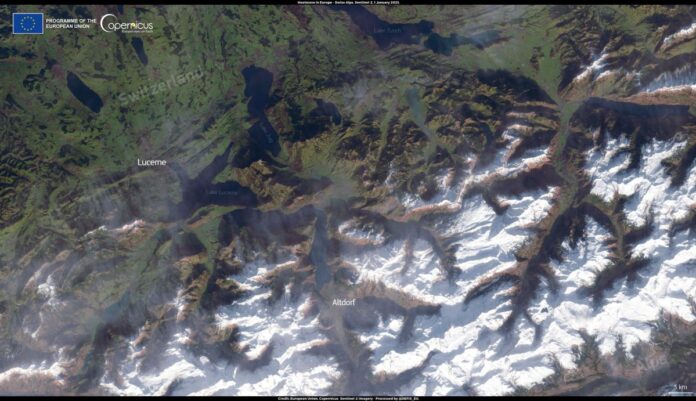Europe entered 2023 with what meteorologists described as the most intense winter heatwave in history.
Forget about ice-covered lakes and landscapes blanketed in snow. New Year’s Day 2023 in many central European countries was about T-shirt weather with temperature records falling like bowling pins all over the continent.
And while many may have enjoyed the sudden respite from freezing cold, climate change experts have sounded alarm bells.
Related: 10 devastating signs of climate change satellites can see from space
In an image taken on Jan. 1, Europe’s Sentinel-2 satellite captured the town of Altdorf in the Swiss Alps where temperatures in this part of the year usually average between 28 and 39 degrees Fahrenheit (minus 2 and plus 4 degrees Celsius). The New Year’s Day of 2023, however, saw daytime temperatures soar to 67 degrees F (19.2 degrees C) with even the night remaining at a balmy 60 degrees F (16 degrees C). Similar extremes were recorded in many other countries across central and northwestern Europe including Denmark, the Netherlands, Poland and the Czech Republic.
Climate scientists and meteorologists from all over the world flocked to Twitter to express their astonishment at the unseasonal heatwave.
“I have never seen a forecast like this. Ever,” NASA climate scientist Ryan Stauffer tweeted (opens in new tab) with a purple-colored image visualizing the “temperature anomaly” across Europe. “The climate implications are hard to ignore,” he added further down the thread.
I have never seen a forecast like this. Ever. pic.twitter.com/j2aFjayiGADecember 30, 2022
Physicist Nahel Belgherze who works at the European Synchrotron research facility in the French Alps shared an animation showing a map of Europe with dozens of colorful dots springing up all over representing temperature records broken across the continent between Dec. 30 and Jan. 1.
“One of the most severe winter heatwaves in Europe’s modern history visualized over the last 2 days,” Belgherze said in the tweet (opens in new tab). “Hundreds of monthly warm temperature records were broken all over the continent. This is exactly the kind of very abnormal event that is progressively rewriting global climatology.”
One of the most severe winter heatwave in Europe’s modern history visualized over the last 2 days. Hundreds of monthly warm temperature records were broken all over the continent. This is exactly the kind of very abnormal event that is progressively rewriting global climatology. pic.twitter.com/Nb8ImytqYCJanuary 1, 2023
For places like Altdorf, such events have particular significance. The town, one of many in Switzerland as well as in other countries that share chunks of Europe’s greatest mountain range, is nestled between snow-capped mountains over 9,800 feet tall (3,000 meters). The Sentinel-2 image shows mostly green, grass-covered landscape with snow covering only the higher-altitude areas, a view disturbing to climate experts who had previously observed concerning record-breaking glacier loss caused by the hot summer of 2022.
According to The Conversation (opens in new tab), 6.2% of the mountain glacier mass in the Swiss Alps melted away that summer. Now the winter season, which usually provides these ice sheets with an annual boost and respite, is witnessing their destruction too. Previously, scientists would consider a 2% annual ice loss as severe.
According to Reuters (opens in new tab), the Alps are warming by 0.5 degree F (0.3 degree C) per decade, which is about twice as fast as the global average. Scenarios based on current greenhouse gas emissions projections foresee that up to 80% of the Alpine glaciers may disappear by the end of this century.
Follow Tereza Pultarova on Twitter @TerezaPultarova. Follow us on Twitter @Spacedotcom and on Facebook.

